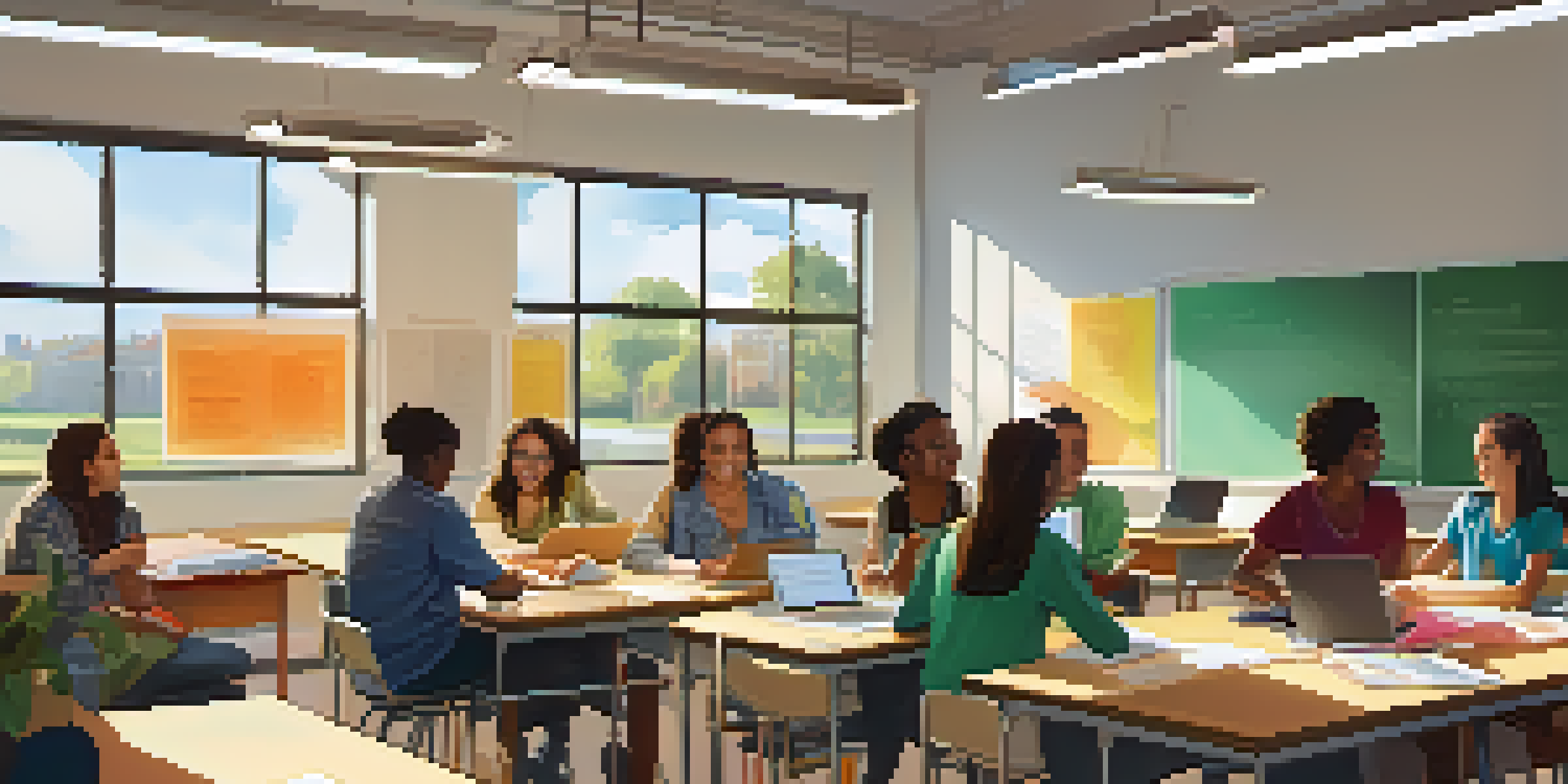Flipped Classroom: Best Practices from Experienced Educators

Understanding the Flipped Classroom Concept
The flipped classroom model turns traditional teaching on its head. Instead of lecturing in class while students do homework at home, educators assign video lectures or reading materials for homework, allowing class time for interactive activities. This approach promotes active learning, where students engage deeply with the content and collaborate with peers.
Tell me and I forget. Teach me and I remember. Involve me and I learn.
Think of it like preparing for a family dinner. You gather ingredients and cook beforehand, so when guests arrive, you can focus on enjoying their company rather than scrambling in the kitchen. Similarly, the flipped classroom model allows students to familiarize themselves with materials before class, leading to richer discussions and deeper understanding.
This method is not just a trend but a shift towards student-centered learning. It empowers students to take ownership of their education, fostering critical thinking and problem-solving skills that are essential in today's world.
Creating Engaging Video Content
One of the cornerstones of a successful flipped classroom is creating engaging video content. Educators should strive to make videos concise and interactive, ideally between 5 to 10 minutes long. This keeps students’ attention and ensures they absorb the key concepts without feeling overwhelmed.

Using visuals, real-world examples, and storytelling techniques can significantly enhance the learning experience. For instance, a history teacher might narrate a historical event like a story, complete with images or animations to draw students in. This makes the content relatable and memorable.
Flipped Classroom Enhances Learning
This model shifts traditional teaching by encouraging students to engage with materials at home, leading to richer classroom interactions.
Additionally, incorporating quizzes or reflection questions at the end of the videos can help reinforce learning. It encourages students to think critically about the material, leading to better comprehension and retention.
Encouraging Student Interaction in Class
Once students come to class prepared, educators can focus on interactive learning experiences. Group discussions, problem-solving activities, and hands-on projects can take center stage. This interaction not only reinforces the content but also builds communication and teamwork skills.
Education is not the filling of a pail, but the lighting of a fire.
Imagine a workshop where everyone contributes ideas and solutions; that’s the essence of a flipped classroom. When students feel comfortable sharing their thoughts, it creates a vibrant learning environment where everyone learns from each other.
Teachers can facilitate this by posing open-ended questions and encouraging students to explore various perspectives. A culture of collaboration in the classroom enhances engagement and fosters a sense of community.
Utilizing Technology for Collaboration
Technology plays a pivotal role in the flipped classroom model. Tools like learning management systems (LMS) and collaborative platforms (like Google Classroom) can streamline communication and provide a central hub for resources. This makes it easy for students to access materials and collaborate with one another.
Think of technology as the backbone of a modern classroom, connecting students and teachers no matter where they are. For instance, students can discuss their thoughts on a video lecture in an online forum, allowing them to engage even outside of classroom hours.
Engaging Video Content is Key
Creating concise and interactive videos helps capture students’ attention and reinforces learning effectively.
Moreover, technology can facilitate personalized learning experiences. Educators can track progress and adapt materials to meet individual student needs, ensuring that everyone moves at their own pace.
Assessing Student Understanding Effectively
Assessment in a flipped classroom should be ongoing and multifaceted. Rather than relying solely on tests, educators can use formative assessments like quizzes, peer reviews, and reflective journals to gauge understanding. This approach provides a clearer picture of student progress and areas needing reinforcement.
For example, after a group project, students could assess each other's contributions, fostering accountability and providing constructive feedback. This not only helps teachers understand student learning but also encourages a growth mindset among peers.
Additionally, incorporating self-assessment tools allows students to reflect on their learning journey. This practice promotes self-awareness and empowers them to take charge of their educational paths.
Building a Supportive Learning Environment
Creating a supportive learning environment is crucial for the success of the flipped classroom. Educators should foster an atmosphere where students feel safe to express their ideas and ask questions without fear of judgment. This encourages risk-taking and exploration, essential components of effective learning.
Consider the classroom as a garden; it needs nurturing to grow. Teachers can cultivate this environment by being approachable, showing enthusiasm for the subject, and celebrating student successes, no matter how small.
Collaboration Boosts Student Success
Utilizing technology and fostering a collaborative environment enables students to work together, enhancing their communication and problem-solving skills.
Furthermore, establishing clear expectations and guidelines helps students feel secure. When they know what is expected of them, they can focus on learning rather than worrying about the rules.
Involving Parents in the Flipped Learning Process
Involving parents in the flipped classroom model can enhance student success. Educators can share resources and strategies with parents to help them understand the approach and support their children’s learning at home. This collaboration creates a cohesive learning environment that extends beyond the classroom.
For instance, teachers might host informational sessions or send newsletters explaining how the flipped classroom works and what parents can do to assist. This ensures parents are equipped to engage with their children about the materials.

Moreover, creating opportunities for parents to participate in classroom activities can further strengthen this connection. When parents are actively involved, it reinforces the importance of education and fosters a community of support.
Reflecting and Adapting Your Approach
Finally, educators should consistently reflect on their flipped classroom practices and adapt as needed. Gathering feedback from students about what works and what doesn’t can provide valuable insights. This iterative process can enhance teaching strategies and improve student outcomes.
Consider it like fine-tuning an instrument; the more you adjust, the better the performance. By being open to change and willing to experiment with new methods, teachers can better meet their students' evolving needs.
Additionally, connecting with a community of educators can offer fresh perspectives and innovative ideas. Sharing experiences and strategies can inspire new approaches that may resonate with different groups of students.